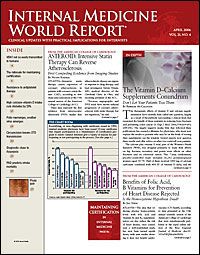Pulmonary-Vein Ablation Can Cure Chronic AF
Atlanta—In a new study of patients with paroxysmal atrial fibrillation (AF) who were treated with circumferential pulmonary-vein ablation, 87% of them were free of recurrent AF at 9 months and no longer needed antiarrhythmic drugs, reported Carlo Pappone, MD, chief, Division of Cardiac Pacing and Electrophysiology, San Raffaele Univer?sity Hospital, Milan, at the 55th annual session of the American College of Cardiology.
Circumferential pulmonary-vein ablation is a radiofrequency procedure used to modify the arrhythmogenic substrate surrounding the pulmonary-vein ostia.
“It’s possible today to cure AF and maintain sinus rhythm at 9 months in about 90% of patients,” said Dr Pappone, lead investigator of the Abla?tion for Paroxysmal Atrial Fibrillation (APAF) trial.
The trial was the first to compare medical therapy with catheter ablation for paroxysmal AF using an appropriately powered, randomized, controlled design.
In the APAF trial, 199 patients who experienced an average of 3 AF episodes per month despite the use of antiarrhythmic drug therapy were randomized to receive drug treatment with amiodarone (Pacerone), flecainide (Tambocor), or sotalol (Betapace), or to circumferential pulmonary-vein ablation.
Patients in both groups received anticoagulation therapy; anticoagulation was discontinued if sinus rhythm persisted, positive left atrial remodeling was documented, or delayed transport function improved.
Preliminary results from the first 150 patients who were followed for at least 9 months showed that a repeat ablation procedure was needed in 9% of those randomized to catheter ablation for recurrent AF or atrial tachycardia. The overwhelming majority (87%) of pa?tients assigned to pulmonary-vein catheter ablation were free of recurrent AF or atrial tachycardia at 9 months, compared with only 29% of patients assigned to drug therapy (P <.001).
All 65 patients treated with ablation who were in normal sinus rhythm at follow-up had stopped taking antiarrhythmic drugs, and all but 1 had discontinued anticoagulation therapy. In this group, AF recurred in 8 patients, 5 of whom were placed on antiarrhythmic drug therapy, and 3 underwent another ablation procedure (1 of whom had recurrent AF).
Of the 52 patients randomized to antiarrhythmic drug therapy who experienced recurrent AF, 38 underwent pulmonary-vein ablation, 4 of whom still had recurrent AF.
No serious adverse events, including no pulmonary vein stenosis, occurred in the group undergoing pulmonary-vein ablation.
Patients aged >70 years and those with an enlarged atrium or ejection ?fraction <35% were excluded from APAF, noted Paul Armstrong, MD, of the University of Alberta, Edmonton, Canada, making it difficult to generalize the results of APAF to patients typically seen in clinical practice. Patients with AF in the community are often older and have a history of heart failure, he said.
In another study comparing the benefits of pulmonary-vein ablation with medical therapy and cardioversion that was recently published in the New England Journal of Medicine (2006;354: 934-941), reported benefits of pulmonary-vein ablation were similar to those demonstrated in the APAF trial.
